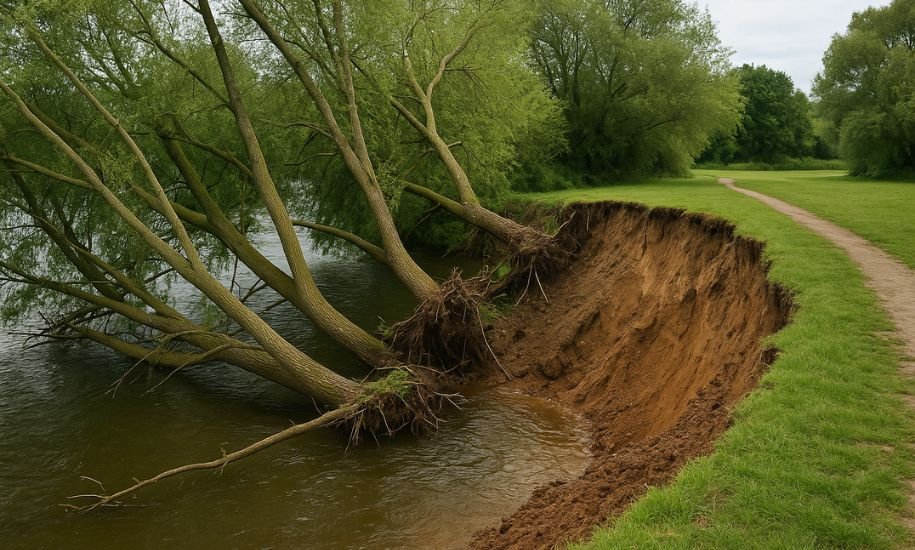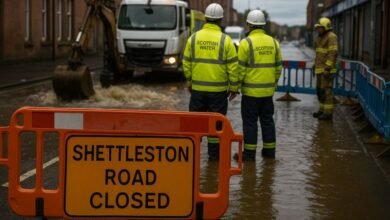Riverbank Collapse Iford Playing Fields: Causes, Impacts, and Lessons from Nature

The recent riverbank collapse at Iford Playing Fields has captured the attention of local residents and environmental observers. Nestled beside the River Stour, this peaceful green space between Bournemouth and Christchurch has long been a place for walkers, cyclists, and nature lovers. Yet, in late May, the landscape changed dramatically when part of the riverbank gave way, sending several trees tumbling into the water and altering the river’s edge.
The Incident: A Sudden Transformation
The riverbank collapse at Iford Playing Fields occurred suddenly, reportedly overnight. Locals awoke to find uprooted trees lying across the River Stour and the edge of the playing field visibly eroded. The embankment failure was significant enough to expose raw soil layers and leave steep, unstable edges.
BCP Council, which manages the area, issued a short statement noting that the event was part of the “natural processes of the river.” Officials confirmed that they were monitoring the site and seeking expert advice to assess safety and environmental impact. Residents quickly shared images and concerns, particularly those who frequent the path near the old railway bridge opposite Bailey Bridge Marina.
Why Did the Riverbank Collapse at Iford Playing Fields?
Several contributing factors help explain the riverbank collapse at Iford Playing Fields, combining natural forces with environmental and human influences.
1. Natural River Erosion
The River Stour is a dynamic waterway, constantly shaping and reshaping its banks through erosion and deposition. Over time, the outer bend near Iford experiences faster flow, which scours the base of the bank — the “toe.” Once the toe is undercut, the upper layers lose support and eventually slide into the river.
2. Saturated Ground and Heavy Rain
Weeks of wet weather leading up to the incident likely played a major role. When the soil becomes saturated, it weakens, and the pressure from water inside the soil pores reduces its stability. Combined with fluctuating river levels, this can lead to sudden slippage and collapse.
3. Tree Root Failure
The trees that fell into the River Stour were part of the natural riverbank reinforcement. As erosion exposed their roots, they lost their grip on the soil. When they toppled, their roots tore away large sections of the bank, worsening the collapse and widening the affected area.
4. Human and Infrastructure Influence
The path running close to the river’s edge and the nearby bridge may have indirectly contributed. Continuous foot traffic and soil compaction close to an eroding edge can accelerate failure. Although the riverbank collapse Iford Playing Fields event is largely natural, human activity often magnifies erosion once it starts.
The Impact on the Environment and Community
Public Safety
The immediate issue following the riverbank collapse at Iford Playing Fields is safety. The riverbank now includes dangerous overhangs and unstable ground that could give way without warning. Local walkers have called for temporary fencing and clear signage to prevent accidents, particularly as the area is popular with families and joggers.
Ecological Effects
While the collapse introduces risks to access, it also plays a role in the natural ecology of the River Stour. The fallen trees now in the river may provide new habitats for fish, insects, and birds. At the same time, soil runoff and sediment can temporarily affect water quality, reducing clarity and disrupting aquatic life until the system rebalances.
Structural Concerns
Residents expressed worries that ongoing erosion might threaten nearby infrastructure, such as the train bridge and pathways. Although no immediate danger has been reported, the council continues to observe the area to ensure that critical structures remain secure.
Council Response and Standard Procedures
BCP Council confirmed it is “monitoring the site and consulting with partners.” Typical responses to a riverbank collapse include:
-
Inspection and Safety Measures: Evaluating the extent of damage and installing warning signs or fencing.
-
Monitoring for Movement: Setting up erosion markers or surveys to measure whether the collapse is continuing.
-
Risk Assessment: Determining whether to intervene immediately or allow natural stabilization.
-
Remedial Works (if needed): Using soft engineering techniques such as willow spiling or coir rolls, or hard defenses like rock armoring if essential infrastructure is threatened.
The council’s statement calling the event “part of natural processes” suggests that a “monitor and manage” approach may be preferred, avoiding heavy engineering unless absolutely necessary.
Community Reactions
Locals who use the playing fields daily have expressed a mix of concern and fascination. Some worry about losing parts of the path and about access for families and dog walkers. Others see the riverbank collapse Iford Playing Fields as a natural reminder that rivers evolve and landscapes are never static.
Environmental enthusiasts have emphasized the importance of respecting natural erosion and seeing it as part of the river’s lifecycle. They argue that these processes should not always be resisted with artificial barriers, especially when they do not endanger people or major assets.
Lessons and Broader Significance
The riverbank collapse Iford Playing Fields event is not an isolated case. Similar erosional changes are happening across the UK as weather patterns intensify and soil moisture fluctuates more frequently due to climate change. This incident highlights the need for:
-
Adaptive Land Management: Designing riverside paths and parks to accommodate natural retreat rather than resist it entirely.
-
Public Awareness: Educating residents about how rivers move and why occasional collapses are inevitable.
-
Balanced Decision-Making: Combining environmental preservation with community safety in managing urban natural spaces.
As climate variability increases, understanding river dynamics will be essential. Councils and communities must plan green spaces that are both accessible and resilient to natural change.
Looking Forward
In the coming months, Iford Playing Fields will likely undergo natural recovery. Vegetation may regrow, stabilizing exposed soil, while the fallen trees in the water may become integral parts of the river’s ecosystem. Whether through active intervention or careful observation, the site will tell its own story of renewal.
For residents, this event underscores the beauty and unpredictability of nature. It serves as a reminder that the River Stour, like all rivers, is alive — shifting, adapting, and continuously reshaping its surroundings.
The riverbank collapse Iford Playing Fields may have altered the landscape, but it also offers a chance to reconnect with the natural forces shaping our environment.
For more updates and in-depth environmental reports, visit American Times — your source for stories that explore the intersection of community, nature, and change.
